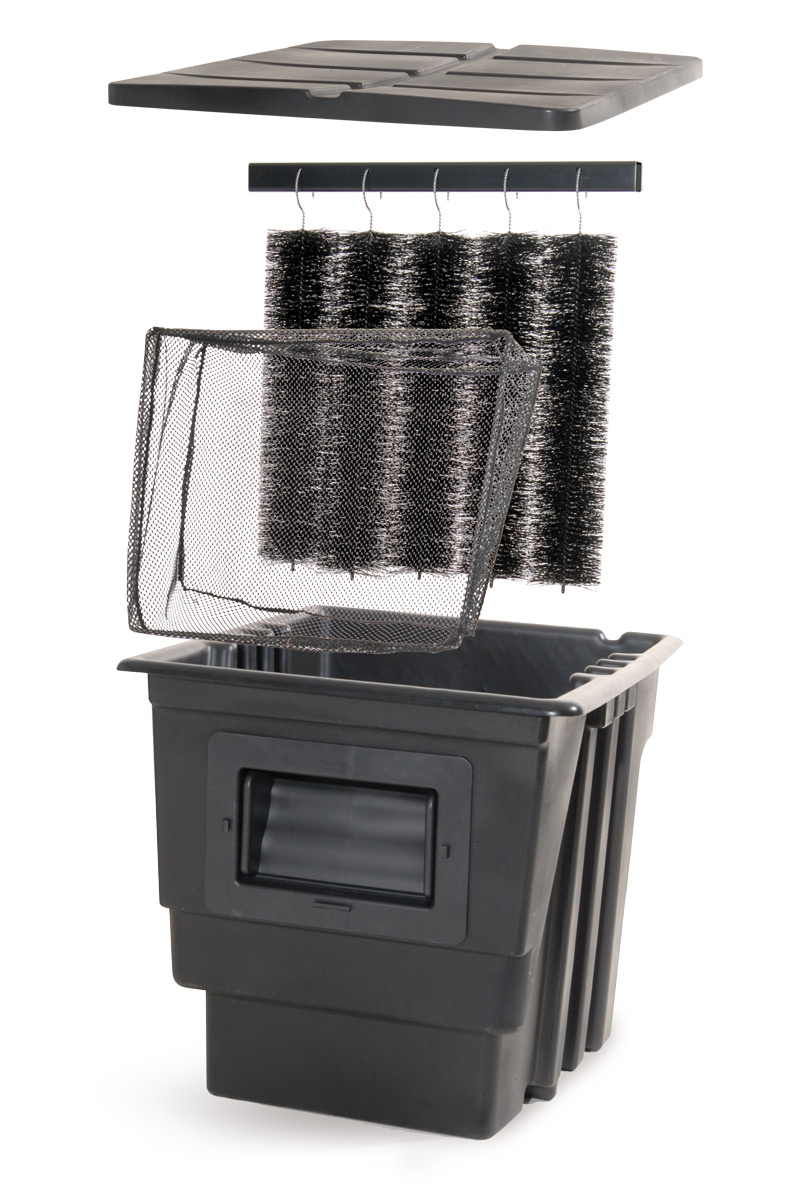Ponds 101 Chapter 8
The Pond Skimmer
Even if pumps tend to work better in skimmers, we need to know what else makes a skimmer worthwhile, since it does represent a considerable additional investment over the cost of the pump alone, so let’s list the advantages. First and foremost, skimmers are great pre-filters, screening out debris that could otherwise clog and possibly damage the pump. Skimmers collect floating leaves and debris that would eventually sink to the bottom, where it’s harder to remove. The skimmer basket or net can be emptied quickly in less time than hand netting; the bigger the basket or net, the longer between cleanings, further reducing maintenance.

Skimmers may also be fitted with brushes, foam pads or other types of filtration media that help keep the pond clean, but this is NOT a primary function – in fact, if filter pads are neglected they can block water flow to the pump, allowing the pump to overheat, actually doing more harm than good. Matala mats and brushes tend to be less prone to clogging, but all skimmers require periodic maintenance, just as all pumps do. Skimmers reduce that maintenance, they do not eliminate it. When it comes to longevity and reduced maintenance, a bigger skimmer is better. The larger the surface area of the net, basket or filter media, the longer it will go between cleanings. The same goes for rated flows. If the skimmer is rated for 2000 to 4000GPH, it will perform better in the lower part of its range, where it will easily deliver the water the pump needs for far longer. It is far better to oversize the skimmer and undersize the pump than the other way around! Finally, the greater longevity of pumps in skimmers, as discussed, directly pays you back by reducing replacement costs over time, probably by 10-15%. The ability to use a “clean water” pump leads to even greater savings, often amounting to 25% less in electric costs in comparison to “solids-handling” pumps. Of course, the bigger the pump, the greater the savings, but just as an example, in the 2000GPH range, that usually means a cost savings of over $100 per year. No wonder they’re so popular! See The Ultimate Prefilter: The Pond Skimmer in the College of Filtration for further information.

The Inner Profile of a typical pond
Even if pumps tend to work better in skimmers, we need to know what else makes a skimmer worthwhile, since it does represent a considerable additional investment over the cost of the pump alone, so let’s list the advantages. First and foremost, skimmers are great pre-filters, screening out debris that could otherwise clog and possibly damage the pump. Skimmers collect floating leaves and debris that would eventually sink to the bottom, where it’s harder to remove. The skimmer basket or net can be emptied quickly in less time than hand netting; the bigger the basket or net, the longer between cleanings, further reducing maintenance.

Skimmers may also be fitted with brushes, foam pads or other types of filtration media that help keep the pond clean, but this is NOT a primary function – in fact, if filter pads are neglected they can block water flow to the pump, allowing the pump to overheat, actually doing more harm than good. Matala mats and brushes tend to be less prone to clogging, but all skimmers require periodic maintenance, just as all pumps do. Skimmers reduce that maintenance, they do not eliminate it. When it comes to longevity and reduced maintenance, a bigger skimmer is better. The larger the surface area of the net, basket or filter media, the longer it will go between cleanings. The same goes for rated flows. If the skimmer is rated for 2000 to 4000GPH, it will perform better in the lower part of its range, where it will easily deliver the water the pump needs for far longer. It is far better to oversize the skimmer and undersize the pump than the other way around! Finally, the greater longevity of pumps in skimmers, as discussed, directly pays you back by reducing replacement costs over time, probably by 10-15%. The ability to use a “clean water” pump leads to even greater savings, often amounting to 25% less in electric costs in comparison to “solids-handling” pumps. Of course, the bigger the pump, the greater the savings, but just as an example, in the 2000GPH range, that usually means a cost savings of over $100 per year. No wonder they’re so popular! See The Ultimate Prefilter: The Pond Skimmer in the College of Filtration for further information.

The Inner Profile of a typical pond




